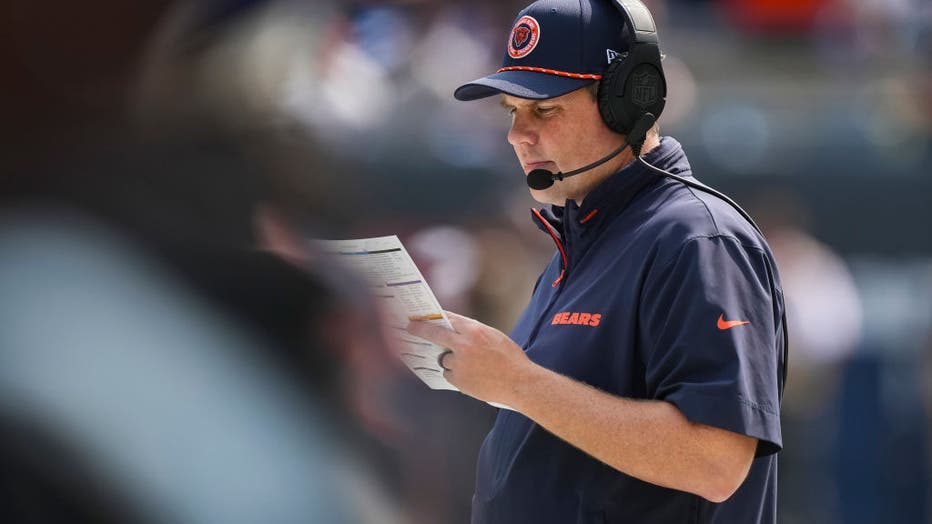Shane Waldron explains why the Chicago Bears' red zone O lines in shotgun, and his accountability process

'I know it can be frustrating': Bears' Kevin Byard addresses fans' concerns after 1-2 start
FOX 32's Lou Canellis goes 1-on-1 with Kevin Byard of the Chicago Bears to discuss the team's loss to the Colts, and the showdown at Soldier Field with the Rams in Week 4.
LAKE FOREST, Ill. - One of the biggest questions that loomed over the Chicago Bears after the loss to Indianapolis had to wait until Thursday for an explanation.
Why did Bears' offensive coordinator operate out of the shotgun formation in goal-to-go situations?
Waldron answered that question on Thursday, and his answer centers around the Bears presenting as much versatility as possible.
"When you're in the shotgun in the low red zone there, you obviously present the option of the quarterback to run it," Waldron said. "I know that when it comes down, everyone will want to talk about it and ask about it."
The biggest reason it's become a talking point this week is operating out of the gun takes the ball from the point of attack and puts it behind the sticks. It also takes away a running start for a running back getting the ball on a carry.
The Bears had eight plays inside the Colts' 10-yard line on Sunday, and the Bears operated in the shotgun formation in all eight plays. The Bears went 2 for 3 in three red zone opportunities, scoring two touchdowns and turning the ball over on downs once on that option play.
Inside the Colts' 10-yard line, the Bears also ran the ball up the middle through the interior of the defense four times. They didn't lose yardage on any of those plays, starting with an interior run with Roschon Johnson on fourth and one that moved the chains.

CHICAGO, IL - SEPTEMBER 8: Offensive coordinator Shane Waldron of the Chicago Bears stands on the sidelines during the third quarter of an NFL football game against the Tennessee Titans, at Soldier Field on September 8, 2024 in Chicago, Illinois. (Ph
The Bears didn't run up the middle of the defense in their latter two red zone trips, but those came in the fourth quarter when the team tried to pass their way back into the game. Most of the run calls inside the 10 came in the second quarter when the Bears came away with nothing.
The Bears were in shotgun for all of those running plays. That's because Waldron wants to present an extra element for defenses to take note of.
"In terms of being in the gun versus being under center, there's different styles of both," Waldron said. "When you present that extra element, because in the low red zone defense has that extra hat down there, quarterbacking in the gun now presents that opportunity."
The one call on that drive plenty are still talking about – and most likely will continue to talk about – is the speed-option play on fourth and goal from the one-yard line.
It was blown up from the start, as the offensive line lost at the point of attack, and went for minus 12 yards, turned the ball over and left the Bears without points on the board.
It didn't work for a myriad of reasons. Most of the reasons start up front with the offensive line, but it's not something Waldron will dwell on for too long.
He wants to learn from it and move on.
"The fourth down call right there, where it didn't work out after we had some interior runs, I know for me, I can't look back at the past and in that negative light," Waldron said. "I got to look back in the past and live in the present, be better for us, learn from it and improve there."
One thing that came to light on Thursday was Waldron's accountability. Tight end Marcedes Lewis said Waldron will list the plays that didn't work and the calls he didn't like coming out of a game.
Bears quarterbacks coach Kerry Joseph, who has been with Waldron for four years now, said that accountability has always been there.
"He's always done that," Joseph said. "He's always been that person to stand in front of us as coaches,
This type of accountability is something Joseph and other coaches have come to respect out of Waldron.
"We all stand there and say, you know what? We could have done better to help him," Joseph said. "Because, at the end of the day, it's about us collectively coming together to make sure we are going in the same direction."


